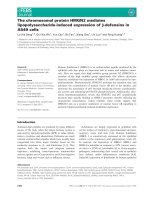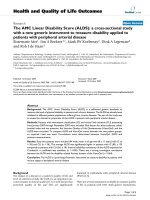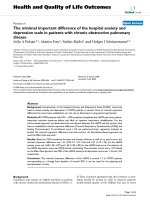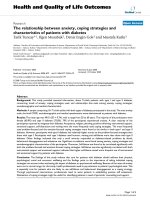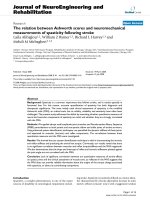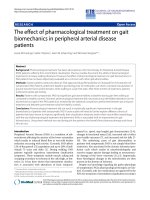Báo cáo hóa học: " The Reflux Disease Questionnaire: a measure for assessment of treatment response in clinical trials" pdf
Bạn đang xem bản rút gọn của tài liệu. Xem và tải ngay bản đầy đủ của tài liệu tại đây (248.38 KB, 6 trang )
BioMed Central
Page 1 of 6
(page number not for citation purposes)
Health and Quality of Life Outcomes
Open Access
Research
The Reflux Disease Questionnaire: a measure for assessment of
treatment response in clinical trials
Michael Shaw
1
, John Dent*
2
, Timothy Beebe
3
, Ola Junghard
4
,
Ingela Wiklund
4
, Tore Lind
4
and Folke Johnsson
5
Address:
1
Park Nicollet Clinic and University of Minnesota Medical School, Minneapolis, MN 55416-2699, USA,
2
Department of Gastroenterology
and Hepatology, Royal Adelaide Hospital, Adelaide, SA 5000, Australia,
3
Mayo Clinic College of Medicine, Rochester, MN 55905, USA,
4
AstraZeneca R&D, SE-431 83 Mölndal, Sweden and
5
University of Lund, SE-221 00 Lund, Sweden
Email: Michael Shaw - ; John Dent* - ; Timothy Beebe - ;
Ola Junghard - ; Ingela Wiklund - ; Tore Lind - ;
Folke Johnsson -
* Corresponding author
Abstract
Background: Critical needs for treatment trials in gastroesophageal reflux disease (GERD)
include assessing response to treatment, evaluating symptom severity, and translation of symptom
questionnaires into multiple languages. We evaluated the previously validated Reflux Disease
Questionnaire (RDQ) for internal consistency, reliability, responsiveness to change during
treatment and the concordance between RDQ and specialty physician assessment of symptom
severity, after translation into Swedish and Norwegian.
Methods: Performance of the RDQ after translation into Swedish and Norwegian was evaluated
in 439 patients with presumed GERD in a randomized, double-blind trial of active treatment with
a proton pump inhibitor.
Results: The responsiveness was excellent across three RDQ indicators. Mean change scores in
patients on active treatment were large, also reflected in effect sizes that ranged from a low of 1.05
(dyspepsia) to a high of 2.05 (heartburn) and standardized response means 0.99 (dyspepsia) and
1.52 (heartburn). A good positive correlation between physician severity ratings and RDQ scale
scores was seen. The internal consistency reliability using alpha coefficients of the scales, regardless
of language, ranged from 0.67 to 0.89.
Conclusion: The results provide strong evidence that the RDQ is amenable to translation and
represents a viable instrument for assessing response to treatment, and symptom severity.
Background
Symptom-focused questionnaires have an important role
in clinical trials of gastroesophageal reflux disease
(GERD) management. This is especially the case given
that symptom relief is a major goal of treatment for
patients with GERD [1], and that patient self-report on
symptom status is now believed to be more reliable than
physician assessment [2]. Critical needs for symptom
evaluation in clinical trials include optimizing symptom-
based selection of research subjects for the trial, evaluating
Published: 30 April 2008
Health and Quality of Life Outcomes 2008, 6:31 doi:10.1186/1477-7525-6-31
Received: 17 September 2007
Accepted: 30 April 2008
This article is available from: />© 2008 Shaw et al; licensee BioMed Central Ltd.
This is an Open Access article distributed under the terms of the Creative Commons Attribution License ( />),
which permits unrestricted use, distribution, and reproduction in any medium, provided the original work is properly cited.
Health and Quality of Life Outcomes 2008, 6:31 />Page 2 of 6
(page number not for citation purposes)
baseline symptom severity, and assessing response to
treatment. These aims need to be achievable with brief,
easily scored questionnaires that are preferably self-
administered. The multicenter, multinational nature of
pharmaceutical clinical trials also requires questionnaires
that are amenable to translation into multiple languages.
The Reflux Disease Questionnaire (RDQ), a 12-item self-
administered questionnaire, was designed to assess the
frequency and severity of heartburn, regurgitation, and
dyspeptic complaints and to facilitate the diagnosis of
GERD in primary care [3]. The psychometric properties of
the RDQ have been examined in a primary care popula-
tion. Internal consistency reliability levels were high, with
alpha coefficients ranging from 0.80 for the dyspepsia
scale to 0.81 and 0.85 for the heartburn and regurgitation
scales, respectively. In terms of stability, the test-retest reli-
ability coefficients ranged from 0.80 to 0.88. An assess-
ment of change scores among a subset of patients
provided initial evidence of the responsiveness of the
RDQ regurgitation and heartburn scales to treatment
effects. Based on these preliminary results, the RDQ may
have the potential to meet some of the questionnaire
needs for GERD clinical trials.
In this study, the performance of the RDQ was assessed in
a clinical treatment trial for patients with GERD. Whereas
prior work on the RDQ was completed with patients seen
in primary care, the current investigation was undertaken
in the context of a multicenter, double-blind, randomized
study in which Scandinavian patients with heartburn as
the predominant symptom were treated with esomepra-
zole for 2 weeks. We extended the earlier psychometric
work on the RDQ by investigating its responsiveness to
changed symptom status as a result of therapy in a large
clinical population of patients diagnosed as having
GERD. The concordance between the RDQ evaluations of
symptom severity was compared to those offered by spe-
cialty physicians. The success of the translation of the
RDQ into Swedish and Norwegian was also evaluated.
Methods
Patients
Adult patients presenting with presumed GERD symp-
toms were recruited from 35 endoscopy units across Swe-
den and Norway [4,5]. Inclusion criteria specified that the
main symptom should be heartburn of six months dura-
tion or longer. Also, patients were required to have had
heartburn episodes on four days or more during the seven
days prior to the one on which they were enrolled. Exclu-
sion criteria included irritable bowel syndrome (IBS) or
any current or historical evidence of a primary esophageal
motility disorder other than reflux disease, as judged by
an investigator. Additional exclusion criteria were major
complications of GERD (such as esophageal stricture,
ulcer and/or Barrett's metaplasia and/or significant dys-
plastic change in the esophagus), the presence of active
gastric or duodenal ulcer or erosive duodenitis, or
esophagitis grade C or D according to the Los Angeles clas-
sification system [6] at the initial screening endoscopy.
Eligible patients were randomly assigned in double-blind
fashion to two weeks of therapy in one of three arms: 1)
esomeprazole 20 mg twice daily (n = 176); 2) esomepra-
zole 40 mg once daily (n = 171); or 3) placebo (n = 92),
in the proportions 2:2:1. For the purpose of this evalua-
tion the two active treatment groups were pooled, as the
results in the two groups were essentially the same.
GERD diagnosis
All patients underwent an endoscopy and pH monitoring,
including assessment of Symptom Association Probability
(SAP). A diagnosis of GERD was considered 'proven'
when either endoscopy (LA grade A or B) and/or pH mon-
itoring (> 3.4% of the total time or > 3.2% of the supine
time with intragastric pH < 4) or SAP (95% or more dur-
ing the 24 hr pH monitoring) was positive.
Measures
The Reflux Disease Questionnaire (RDQ)
The RDQ is a self-administered questionnaire in which
subjects are asked to report the frequency and severity of
their upper gastrointestinal symptoms. There are three
subscales that evaluate regurgitation, heartburn, and dys-
pepsia [3]. The heartburn and regurgitation subscales can
be combined into a GERD dimension. In the published
survey, the time referent is symptoms that have occurred
over the last four weeks. In this study, the time referent
was the last four weeks at baseline, but one week at the
post-treatment visit (visit 2, after two weeks of treatment).
Item content includes the following: 1) four items on the
frequency and severity of acid taste in the mouth and
movement of materials upwards from the stomach
(Regurgitation scale); 2) four items measuring the fre-
quency and severity of pain or burning behind the breast-
bone (Heartburn scale); and 3) four items on the
frequency and severity of pain or burning in the upper
stomach (Dyspepsia scale). Response options were scaled
as Likert-type with scores ranging from 0 to 5 for fre-
quency (not present to daily) and severity (not present to
severe). Each subject's score was calculated as the mean of
item responses with higher scores indicating more severe
or frequent symptoms. The psychometric properties of the
RDQ are described in more detail by Shaw and colleagues
[3].
Overall Treatment Evaluation (OTE)
The OTE, a validated scale, rates the change in symptoms
on a 15-point scale (-7 to -1 = worse; 0 = no change; and
+1 to +7 = better) [7-9]. At the second clinic visit, patients
were asked to fill in the OTE questionnaire and rate if their
Health and Quality of Life Outcomes 2008, 6:31 />Page 3 of 6
(page number not for citation purposes)
symptoms were better, worse, or unchanged. If their
symptoms had changed, patients were asked to rate the
magnitude of improvement or worsening on a seven-
point scale ranging from 1 to 7. In the present analysis
worsening was collapsed into one category, a little better
was defined as +1 to +4, while much better was defined as
+5 to +7.
Other assessments
At both clinic visits, a clinical trial assessment interview
and a physical examination were conducted by the inves-
tigators. Patients were asked about the severity of their
heartburn, regurgitation, dysphagia, epigastric pain, and
nausea over the three days prior to each clinic visit, this
inquiry being structured by the trial case record form for
each visit and graded 0 = none, 1 = mild, 2 = moderate,
and 3 = severe.
Translation and cultural adaptation
The RDQ was translated into Norwegian and Swedish
according to international principles [10]. The translators
met with members of the RDQ survey team to maintain
content and clarity of the questionnaire. As part of the
translation process, the Swedish and Norwegian language
versions were tested with GERD patients. The RDQ was
back translated into English after translation into both
languages and reviewed again by members of the RDQ
survey team to ensure preservation of content and clarity
of the items.
Analytical Strategy
There were three specific analytical objectives: 1) assess-
ment of the responsiveness to treatment of selected RDQ
scales; 2) assessment of the concordance between RDQ-
and physician-generated ratings of disease severity; and 3)
assessment of the internal consistency reliability of the
translated versions to verify the consistency of the con-
cepts. Responsiveness was determined by comparison of
RDQ data to global symptom change reported on the OTE
question. The change from baseline should be larger for
patients who were 'better' according to OTE than for those
who were 'worse or 'unchanged'. Student's t test for paired
samples, the standardized response mean [11], and the
effect size [12] were also calculated. The associations
between the RDQ dimensions heartburn, regurgitation
and dyspepsia, and the corresponding symptom severity
assessments made by the physician is a measure of the
ability of RDQ to measure what it is intended to measure.
Physician severity assessment was compared to RDQ data
with Pearson correlation coefficients and one-way analy-
sis of variance (ANOVA) on mean scale score differences
across physician severity rating categories. Internal con-
sistency refers to the extent to which the items within a
scale are interrelated. High values would imply that the
items within a scale belong together also after the transla-
tion. The consistency of the translation across three lan-
guages was estimated by calculating the internal
consistency reliability using Cronbach's alpha [13].
Results
Patients
134 subjects from Norway and 305 from Sweden with a
mean age of 51.4 (13.5) years were enrolled at 35 sites.
The baseline characteristics and clinical information for
patients with data from both a baseline and subsequent
visit are provided in Table 1. GERD was proven in 82% of
subjects while in 18% the diagnosis was based solely on
symptoms. Symptom severity as judged by investigators
and the RDQ and the response to esomeprazole treatment
was not different for those with proven GERD as opposed
to those in whom objective testing was negative.
Responsiveness
After two weeks of trial therapy, patients were told to
assess symptoms during the previous seven days and com-
pleted the RDQ a second time. Responsiveness was first
examined by collapsing responses on the OTE question to
four possibilities (worse, the same, a little better, and
much better), as described above. A progressive increase
was seen in the change score moving from the worse to
much better categories, regardless of the treatment group
(Table 2). Table 3 shows effect sizes and standardized
response means.
The observed effect sizes ranged from a low of 1.05 (dys-
pepsia) to a high of 2.05 (heartburn). As anticipated, the
Table 1: Demographic and clinical characteristics at initial visit
n = 439 %
Gender
Male 224 51
Age
< 50 188 43
50–64 166 38
> 65 85 19
Country
Norway 134 31
Sweden 305 69
Endoscopic grading
Normal 199 45
Grade A 135 31
Grade B 105 24
Method of GERD diagnosis
a
Endoscopy 240 55
pH monitoring 270 62
Symptom Association 95 22
Total proven diagnoses 354 81
a
Percentages do not add up to 100 due to multiple methods of
diagnosis.
Health and Quality of Life Outcomes 2008, 6:31 />Page 4 of 6
(page number not for citation purposes)
responsiveness of the heartburn scale was highest and the
dyspepsia scale the lowest of the three scales.
It must be noted that a sizable change in scores was
observed for those in the placebo group who indicated
they were at least a good deal better on the OTE item.
Esomeprazole in either dose was markedly more effective
than placebo in improving the GERD score (p < 0.0001)
(Figure 1). Esomeprazole in either dose improved the
GERD score (mean change 2.12; 95% confidence interval:
1.98, 2.26) markedly more effectively than placebo (mean
change 0.93; 95% confidence interval: 0.91, 1.43), p <
0.0001.
RDQ and Physician Severity Rating Concordance
Table 4 depicts the relationships between the scores on
the three RDQ scales and physician symptom severity rat-
ings for regurgitation, heartburn, and dyspepsia at base-
line and at visit 2. A positive correlation was found
between physician severity ratings and RDQ scale scores,
which increased with the investigator ratings of symptom
severity. The observed correlations were strongest at the
follow-up visit (see bolded coefficients).
Internal consistency of the translated RDQ
High levels of internal consistency across the translated
RDQ scales would be evidence of the amenability to trans-
lation. Analysis revealed that, regardless of language, all
but one of the alpha coefficients for the scales of heart-
burn, regurgitation, dyspepsia and GERD (Norway: 0.67,
0.8, 0.88, and 0.72, respectively; Sweden: 0.75, 0.86, 0.89
and 0.78, respectively) surpassed the accepted level of
0.70 [14].
Discussion
The RDQ was developed to facilitate the identification of
GERD in primary care and this was the setting in which its
psychometric properties were established [3]. This study
demonstrated the utility of the RDQ to evaluate treatment
response in a clinical trial of a new medication. The ques-
tionnaire effectively differentiated various levels of
patient-assessed symptom severity compared to physi-
cian-assessed severity. Consistency of performance in two
languages was also observed. The study population, being
highly enriched for GERD, precluded determination of
the predictive validity of the RDQ for a GERD diagnosis.
The responsiveness of the RDQ scales to treatment was
observed to be quite high by all three methods of analysis.
Table 3: Responsiveness indicators for all patients by esomeprazole and placebo treatment
RDQ Scale Effect size Standardized response mean
Esomeprazole Placebo Esomeprazole Placebo
Heartburn 2.05 0.85 1.52 0.74
Regurgitation 1.36 0.63 1.31 0.60
Dyspepsia 1.05 0.56 0.99 0.57
GERD
a
2.13 0.93 1.68 0.79
a
Heartburn and regurgitation subscales combined.
Table 2: Change in the RDQ scales from baseline to 2 weeks, by patient rating of the Overall Treatment Evaluation (OTE)
OTE N Heartburn Regurgitation Dyspepsia GERD
a
Mean SD Mean SD Mean SD Mean SD
Esomeprazole
Worse 6 0.04 2.00 -0.42 0.41 -0.08 1.47 -0.19 1.20
The same 36 0.76 1.48 0.68 1.11 0.31 1.24 0.71 0.99
A little better 43 1.60 1.46 1.52 1.08 1.27 1.64 1.56 0.97
Much better 231 2.74 1.26 2.25 1.42 1.94 1.59 2.51 1.08
All 316 2.31 1.52 1.92 1.47 1.64 1.66 2.12 1.26
Placebo
Worse 3 0.42 1.18 -0.25 0.25 0.50 0.43 0.08 0.63
The same 26 0.42 1.54 0.37 1.30 0.27 1.41 0.37 1.08
A little better 28 0.88 1.0 1.05 1.10 0.78 1.20 0.90 0.72
Much better 22 2.10 1.26 1.38 1.82 1.65 1.68 1.74 1.33
All 79 1.05 1.43 0.86 1.43 0.86 1.50 0.93 1.17
a
Heartburn and regurgitation subscales combined. SD, standard deviation.
Health and Quality of Life Outcomes 2008, 6:31 />Page 5 of 6
(page number not for citation purposes)
The observed effect sizes outstripped conventional thresh-
olds for superior responsiveness [15]. While, as antici-
pated, the responsiveness was somewhat lower for the
dyspepsia scale, it too was quite large. These results pro-
vide clear evidence that the RDQ is sensitive to clinically
important change in the context of a treatment trial. The
effect sizes noted in the placebo group, as a whole, were
clearly lower than those in the active treatment group.
When split according to the OTE responses, which meas-
ure the patient's perception of improvement, the effect
sizes were more or less comparable to those in the active
treatment group. However, only 22 patients reported that
they were 'much better' in the placebo group compared to
231 in the esomeprazole-treated group, indicating the
superiority of active therapy.
An important aspect of a useful symptom questionnaire is
its ability to capture nuances in various disease symptom
complexes. Evidence that an instrument is able to capture
severity would be particularly useful because disease
severity often directs different courses of treatment. The
purpose of the current study was to evaluate how well the
RDQ tracked physician ratings of disease severity for
regurgitation, heartburn, and dyspepsia. The results dem-
onstrated that the RDQ is quite sensitive to symptom
severity as measured by specialty physicians. The fact that
the concordance between the two sources was more pro-
nounced at the follow-up visit may be due to several fac-
tors, e.g. practice effects (on both the patient's and
physician's part), compression of symptom evaluations at
the follow-up visit in response to treatment (most patients
got better), and/or a more comparable time referent
between both data sources at the follow-up. The results of
a recent paper argue for the use of a self-report survey to
supplement investigator obtained data in this critical step,
especially if the primary outcome measurement tool is
going to be a self-report symptom measure [16]. In this
study, before treatment, the concordance between how
physicians and patients rated symptom severity of heart-
burn and epigastric pain was only modest and moreover,
the physicians consistently underestimated symptom
severity. If complete symptom resolution was achieved
there was good agreement after treatment between physi-
cian and patient ratings; with increasing severity of
remaining symptoms, the concordance decreased signifi-
cantly.
Development of subjective, self-report questionnaires for
symptom assessment requires rigorous psychometric eval-
uation. Development and psychometric evaluation of
instruments includes item selection and multitrait scaling,
internal consistency of items that combine into a dimen-
sion [17], as well as confirmation of convergent and/or
discriminant validity. Although such validation is a neces-
sary component of instrument development, it is not suf-
ficient to guarantee that the instrument will perform well
Table 4: Correlations between RDQ scale scores and clinical severity assessments at baseline and visit 2
RDQ Scale Clinical Severity Assessment
Regurgitation Heartburn Dyspepsia GERD
Baseline
Regurgitation 0.54 0.14 0.09 0.51
Heartburn 0.21 0.33 0.20 0.29
Dyspepsia 0.26 0.17 0.47 0.18
GERD
a
0.51 0.29 0.18 -
Visit 2
Regurgitation 0.63 0.56 0.40 0.62
Heartburn 0.49 0.74 0.42 0.73
Dyspepsia 0.53 0.67 0.58 0.46
GERD
a
0.62 0.73 0.46 -
a
Heartburn and regurgitation subscales combined.
Values are Pearson's correlation coefficients. Results in bold denote those within similar domains.
Responsiveness of GERD ScoreFigure 1
Responsiveness of GERD Score.
Publish with BioMed Central and every
scientist can read your work free of charge
"BioMed Central will be the most significant development for
disseminating the results of biomedical research in our lifetime."
Sir Paul Nurse, Cancer Research UK
Your research papers will be:
available free of charge to the entire biomedical community
peer reviewed and published immediately upon acceptance
cited in PubMed and archived on PubMed Central
yours — you keep the copyright
Submit your manuscript here:
/>BioMedcentral
Health and Quality of Life Outcomes 2008, 6:31 />Page 6 of 6
(page number not for citation purposes)
when used in an actual clinical trial setting where respon-
siveness to change is the most important criterion. Cou-
pled with the prior work on the RDQ [3], the results of the
current investigation provide strong evidence that the
RDQ represents a viable instrument for assessing symp-
tom severity, subject selection and response to treatment
in clinical trials of GERD. Work focusing on the perform-
ance of the RDQ for epidemiological survey (or tool) and
for GERD diagnosis in primary care is currently underway.
Conclusion
This study provides evidence that the RDQ is amenable to
translation into Norwegian and Swedish, and that it rep-
resents a viable instrument for assessing symptom severity
and response to treatment in clinical trials of patients with
GERD.
Competing interests
The authors declare that they have no competing interests.
Ola Junghard and Tore Lind are AstraZeneca employees,
and Ingela Wiklund was an employee at the time of the
study.
Authors' contributions
FJ was the principal investigator in the study, and was
involved in the design. MS, TB, TL, OJ, and JD were
involved in the analysis, reporting and writing up of the
manuscript. All authors read and approved the final man-
uscript.
Acknowledgements
The authors regretfully acknowledge the unexpected passing of their col-
league and friend, Rolf Carlsson, who was the initiator of this study.
Members of the RDQ Working Group contributed throughout the design
and analysis of the study and manuscript preparation. Members include Pali
Hungin, Roger Jones, Nicholas J. Talley, and Nimish Vakil.
Sander Veldhuyzen van Zanten contributed a number of helpful suggestions
during manuscript preparation.
References
1. Dent J, Armstrong D, Delaney B, Moayyedi P, Talley NJ, Vakil N:
Symptom evaluation in reflux disease: workshop back-
ground, processes, terminology, recommendations, and dis-
cussion outputs. Gut 2004, 53(Suppl IV):iv1-24.
2. U.S. Department of Health and Human Services, Food and Drug
Administration: Guidance for Industry. Patient reported out-
come measures: use in medical product development to sup-
port labeling claims. 2006 [ />5460dft.pdf]. (accessed 21 January 2008).
3. Shaw M, Talley NJ, Beebe T, Rockwood T, Carlsson R, Adlis S, Fend-
rick AM, Jones R, Dent J, Bytzer P: Initial validation of a diagnos-
tic questionnaire for gastroesophageal reflux disease. Am J
Gastroenterol 2001, 96:52-57.
4. Johnsson F, Hatlebakk JG, Klintenberg AC, Román J, Toth E, Stub-
beröd A, Falk A, Edin R: One-week esomeprazole treatment: an
effective confirmatory test in patients with suspected gas-
troesophageal reflux disease. Scand J Gastroenterol 2003,
38:354-359.
5. Johnsson F, Hatlebakk JG, Klintenberg AC, Román J: Symptom-
relieving effect of esomeprazole 40 mg daily in patients with
heartburn. Scand J Gastroenterol 2003, 38:347-353.
6. Lundell LR, Dent J, Bennett JR, Blum AL, Armstrong D, Galmiche J-P,
Johnson F, Hongo M, Richter JE, Spechler SJ, Tytgat GN, Wallin L:
Endoscopic assessment of esophagitis: clinical and functional
correlates and further validation of the Los Angeles classifi-
cation. Gut 1999, 45:172-180.
7. Jaeschke R, Singer J, Guyatt G: Measurement of health status.
Ascertaining the minimal clinically important difference.
Control Clin Trials 1989, 10:407-415.
8. Juniper EF, Guyatt GH, Willan A, Griffith LE: Determining a mini-
mal important change in a disease-specific quality of life
questionnaire. J Clin Epidemiol 1994, 47:81-87.
9. Lydick E, Epstein RS: Interpretation of quality of life changes.
Qual Life Res 1993, 2:221-226.
10. Guillemin F, Bombardier C, Beaton D: Cross-cultural adaptation
of health-related quality of life measures: literature review
and proposed guidelines. J Clin Epidemiol 1993, 46:1417-1432.
11. Guyatt GH, Juniper EF, Walter SD, Griffith LE, Goldstein RS: Inter-
preting treatment effects in randomized trials. BMJ 1998,
316:690-693.
12. Kazis LE, Anderson JJ, Meenan RF: Effect sizes for interpreting
changes in health status. Med Care 1989, 27:S178-189.
13. Cronbach LJ:
Coefficient alpha and the internal structure of
tests. Psychometrika 1951, 16:297-334.
14. Carmines EG, Zeller RA: Reliability and validity Assessment. In
Sage University Paper series on Quantitative Applications in the Social Sci-
ences, 07–17 London: Sage Publications; 1979.
15. Cohen J: Statistical power analysis for the behavioral sciences New York:
Academy Press; 1977.
16. McColl E, Junghard O, Wiklund I, Revicki DA: Assessing symptoms
in gastroesophageal reflux disease: how well do clinicians'
assessments agree with those of their patients? Am J Gastroen-
terol 2005, 100:11-18.
17. Streiner DL, Norman GR: Health measurement scales: a practical guide
to their development and use 2nd edition. Oxford: Oxford University
Press; 1995.
